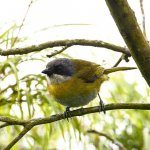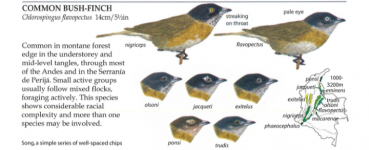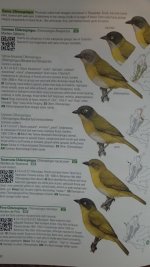-
Welcome to BirdForum, the internet's largest birding community with thousands of members from all over the world. The forums are dedicated to wild birds, birding, binoculars and equipment and all that goes with it.
Please register for an account to take part in the discussions in the forum, post your pictures in the gallery and more.
You are using an out of date browser. It may not display this or other websites correctly.
You should upgrade or use an alternative browser.
You should upgrade or use an alternative browser.
Colombia, Bogotá region, 03/20 (1 Viewer)
- Thread starter Lanugoh
- Start date
More options
Who Replied?Brian J Small
Well-known member
Ashy-throated Chlorospingus
AveryBartels
Well-known member
This is Common Chlorospingus. The subspecies (flavopectus) around Bogota have darker, dusky eyes but note the darker head than Ashy-throated shows. This is an EXTREMELY common error for the Bogota area. A while back I went through and reviewed a bunch of these errors in eBird media but there are likely a bunch more now from places like Chicaque Natural Park.
Not calling this into question (thanks for the note): does it mean the proaves guide is wrong? It shows flavopectus with a pale eye.This is Common Chlorospingus. The subspecies (flavopectus) around Bogota have darker, dusky eyes but note the darker head than Ashy-throated shows. This is an EXTREMELY common error for the Bogota area. A while back I went through and reviewed a bunch of these errors in eBird media but there are likely a bunch more now from places like Chicaque Natural Park.

flavopectus is shown with a quite dark eye in the WCS guide (Quinones).Not calling this into question (thanks for the note): does it mean the proaves guide is wrong? It shows flavopectus with a pale eye.
Niels

I guess my real message is that this book might be better than I initially thought.Here is a scan from the page I was referring to
Niels
Niels
Yes illustrations look good (although choice of map colours indistinguishable). We need AndyAdcock to tell us how the new Hilty guide stacks upI guess my real message is that this book might be better than I initially thought.
Niels
Andy Adcock
Worst person on Birdforum

Best I can do with a 2 year old climbing on me, top image is flavopectus......Yes illustrations look good (although choice of map colours indistinguishable). We need AndyAdcock to tell us how the new Hilty guide stacks up
Attachments
Last edited:
Andy Adcock
Worst person on Birdforum

Short answer would seem to be yes.Not calling this into question (thanks for the note): does it mean the proaves guide is wrong? It shows flavopectus with a pale eye.
Great thanks. So far conclusion seems to be "probably need all 3 guides". Proaves gives better indication of subspecies ranges and illustrates some the others don't (but illustrations not great even when correct). Quinones/Hilty illustrates subspecies correctly & pics are good. Quinones shows more sspp. Hilty gives more background. Good thing my mobile has a micro SD...Short answer would seem to be yes.
Andy Adcock
Worst person on Birdforum

So what's the consensus now, I favour Ashy-throated?
Last edited:
Andy Adcock
Worst person on Birdforum

I see that Ashy-throated is illustrated in the Lynx guide, with a pale, lower mandible compared to the all dark bill of flavopectus, don't know if this might be a separating feature?I would tend to go with Avery Bartels who seems to have the local knowledge the rest of us are missing. Checking the images on BoW for Ashy-throated just convinced me, that is NOT the OP bird. flavopectus for me.
Niels

take a look at the images hereI see that Ashy-throated is illustrated in the Lynx guide, with a pale, lower mandible compared to the all dark bill of flavopectus, don't know if this might be a separating feature?
https://ebird.org/species/atbtan1
The contrast between throat and head is just so much less than what is shown in the OP photo.
Niels
Brian J Small
Well-known member
I agree - Common Chlorospingus flavopectusI would tend to go with Avery Bartels who seems to have the local knowledge the rest of us are missing. Checking the images on BoW for Ashy-throated just convinced me, that is NOT the OP bird. flavopectus for me.
Niels
Brian
Andy Adcock
Worst person on Birdforum

Yet in the Lynx guide, looks almost white?take a look at the images here
https://ebird.org/species/atbtan1
The contrast between throat and head is just so much less than what is shown in the OP photo.
Niels
Last edited:

The photos I saw: if the throat was near white then the crown was paler than what we see here; and if the crown was darker almost like here, then the throat was decidedly grey. So less difference between crown/sides of head and throat than on this image.Yet in the Lynx guide, looks almost white?
Niels
Users who are viewing this thread
Total: 2 (members: 0, guests: 2)








